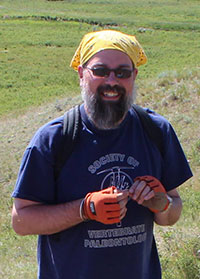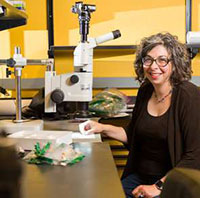 Jonathan M.G. Perry. Department of Physical Therapy Education, College of Health Sciences–Northwest, Western University of Health Sciences, 2665 S. Santiam Hwy., Lebanon, Oregon, 97355, U.S.A. jperry@westernu.edu
Jonathan M.G. Perry. Department of Physical Therapy Education, College of Health Sciences–Northwest, Western University of Health Sciences, 2665 S. Santiam Hwy., Lebanon, Oregon, 97355, U.S.A. jperry@westernu.edu
Jonathan Perry is an Associate Professor in the Department of Physical Therapy Education at Western University of Health Sciences in Lebanon, Oregon. He earned a Bachelor of Science (Honors) in Palaeontology at the University of Alberta in 1998, a Master of Science in Systematics and Evolution at the University of Alberta in 2001, a Ph.D. in Biological Anthropology and Anatomy at Duke University in 2008, and then completed a Postdoctoral Fellowship at Stony Brook University. His research focuses on the chewing system in primates, the interplay between diet and dental morphology, and the early evolution of primates.
![]()
 Alex R. Dutchak. Department of Geoscience, University of Calgary, Calgary, Alberta, T2N 1N4, Canada. alexander.dutchak@ucalgary.ca
Alex R. Dutchak. Department of Geoscience, University of Calgary, Calgary, Alberta, T2N 1N4, Canada. alexander.dutchak@ucalgary.ca
Alex Dutchak is an Associate Professor in the Department of Geoscience at the University of Calgary. He earned a Bachelor of Science (Honors) in Palaeontology at the University of Alberta in 2001, a Master of Science in Systematics and Evolution at the University of Alberta in 2005, and a Ph.D. in Geological and Earth Sciences/Geosciences in 2010. He is a paleobiologist/geoscientist with interests in teaching at the university level, mammalian paleoecology, and paleoclimatology.
![]()
 Jessica M. Theodor. Department of Biological Sciences, University of Calgary, Calgary, Alberta, T2N 1N4, Canada. jtheodor@ucalgary.ca
Jessica M. Theodor. Department of Biological Sciences, University of Calgary, Calgary, Alberta, T2N 1N4, Canada. jtheodor@ucalgary.ca
Jessica Theodor is a Professor of Ecology and Evolutionary Biology in the Department of Biological Sciences at the University of Calgary. She earned a Bachelor of Science in Palaeontology at the University of Toronto in 1989, a Ph.D. at the University of California at Berkeley in 1996, and then completed a Postdoctoral Fellowship at UCLA. Her research focuses on understanding the causes of organismal diversity patterns found over geologic time. Her research into ungulate diversity patterns has taken two distinct approaches to these factors, one focusing on morphological evolution and patterns of diversification in a single lineage (Cetartiodactyla), and the other on extrinsic causes of changes in diversity in feeding guilds of ungulates during the Miocene.

